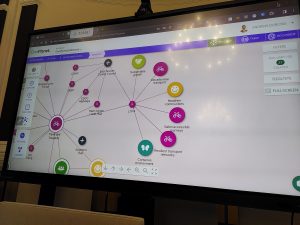
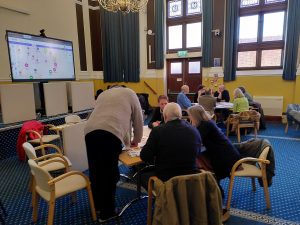
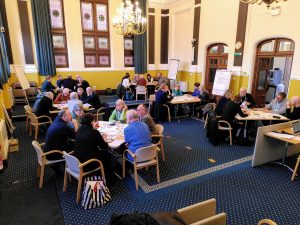
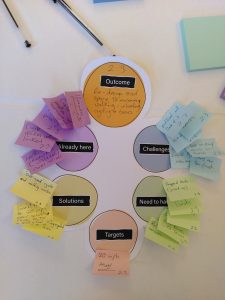

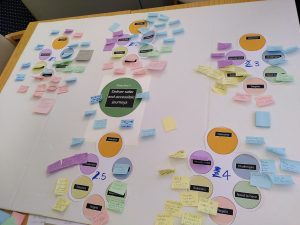
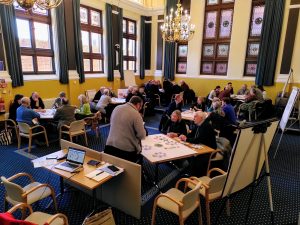
The consultation for East Sussex county Council’s Local Transport Plan 4 closes on Sunday 25th February 2024.
If you haven’t already submitted your response, you may be interested in the outcomes of an LTP4 workshop/meeting organised by Eastbourne Eco Action Network and held at Eastbourne Town Hall, on Monday 12th February.
But first, some general comments:
LTP4 contains a list of six objectives and we can agree with most of these. The problem is that there is no clear commitment to achieve any of these objectives. No measurable targets and no review dates have been set to monitor progress. The implementation plan lists many schemes we’d all like to see, but these are all subject to funding sources, which haven’t been agreed. We’re unlikely to see many of these schemes implemented in the medium term, but theoretically the consultation process should help to identify priorities. Sadly, the form only allows for a few free text inputs with 3000 characters (not words) in each, so we have to be really selective about what we choose to include..
Essential things missing in LTP4 include a target to reduce traffic – that’s fundamental.
The LTP4 Health Impact Assessment states in item 2.6 that
“The theme ‘safety, health and air quality’ was ranked as the most important in ESCC with 79% of respondents selecting it as an important theme for the forthcoming LTP.”
Why then, are there no significant plans to introduce 20mph speed limits in urban areas? 20mph urban speed limits are being introduced across the UK, widely acknowledged to improve road safety, encourage active travel, which in turn reduces congestion and improves air quality. East Sussex is falling behind.
We should remind ESCC that 85% of pedestrian casualties are on 30mph roads and the number is increasing in East Sussex. Also, contrary to messages that regularly come from ESCC, you need 20mph speed limits across wide areas to see real benefit – and this would be cheaper to implement than short stretches with speed bumps. Wales has already seen speed limits reduce by 4mph, which will lead to 24% fewer collisions , fewer deaths and severe injuries and will have a significant impact on the NHS.
There is a serious lack of commitment to develop cycle networks that people will be able to, and want to, use for their daily commutes and leisure activities. Worth noting that Eastbourne is in the UK bottom 15% for cycle safety. A high priority for Eastbourne is a safe seafront cycle path.
Cars are getting bigger, more dangerous for pedestrians and cyclists, more damaging to roads and they take up more space on our streets. Can ESCC introduce higher parking charges for bigger cars?
Brighton & Hove have shown how bus priority measures encourage people to move from cars to buses. We’d ask ESCC, as well as our district and borough councils, to be brave and help to get more introduced.
LTP4 plans for rural bus services centre around Flexibus, but 95% of Demand Responsive Transport schemes are making a loss.
Reducing rail season ticket prices has been shown to lead to an increase in passenger numbers and profit.
What we didn’t want to see: Building new roads and widening existing ones is still high on the LTP4 agenda, even though we know that widening roads doesn’t ease congestion, it just moves it a bit further down the road. Putting in a new road doesn’t always help the economy (SACTRA conclusions).
And, maybe suggest that if our council want more people to engage in consultations that have far reaching implications, they could make them a little easier for the general public to engage with. The documents are well written, but lack pictures and positive visions of what change could look like.
We recommend reading Guidance notes on LTP4 from Paul Humphreys for more help on completing the LTP4 consultation.
Below you will find the output from our recent meeting, starting with those all important key targets, followed by a range of ideas and suggestions for the implementation plan. Note that some are already in LTP4 – but it can’t hurt to emphasise what your priorities are.
On this page:
Other useful information sources:
ESCC have identified some KPIs here for monitoring and evaluating their implementation plans. Some of these align perfectly with our own, although no figures have been published yet and no review dates identified. This must happen and we need to emphasise this in any response to the consultation. Suggest 5 year interim targets, review every 2 years.
The ESCC targets are listed below alongside additional and revised targets identified by EEAN and participants at the recent LTP4 meeting. We have added references to the LTP4 Themes and Objectives they support.
EEAN notes
EEAN notes
EEAN notes
EEAN notes
EEAN Notes
This target is too loose and would allow for business as usual.
Our firm aim should be that all new housing developments include provision for regular public transport services, and safe routes for cyclist and pedestrians. This revised target is key as it supports all 6 LTP4 objectives
EEAN Notes
EEAN notes
Supports Theme D
The following key targets were identified as missing from the LTP4 implementation plan:
and
In addition to the key targets, or KPIs, there are a number of secondary targets that should be considered, since achieving these is key to achieving the key targets above.
Noise pollution is harmful to physical and mental well-being and have a significant impact on the economy. According to research from UK Health Security Agency, 40% of population are exposed to harmful levels of road traffic noise and the equivalent of 130,000 healthy life years are lost from noise pollution each year in Britain. Sleep disturbance is estimated to cost the uK economy £34 billion a year (RAND Europe). UK parliament update on noise and light pollution.
Traffic hotspots, particularly near residential areas, should be monitored and targets set to reduce noise pollution.
The following suggestions were identified by participants at the recent LTP4 meeting. Some are already part of the LTP4 implementation plan, albeit with no identified funding or commitment. We kept everything we could read in – this is an uncensored list of suggestions. Look for ones you feel strongly about.
We didn’t have time to rank these suggestions during the meeting, but we are still keen to know what your priorities are. We can use this information to push for change with our local councils. If you have ten minutes to spare, please look at our priorities survey.
Meanwhile, you may find some suggestions from the list below you want to include in your response to the LTP4 consultation.
Congestions hinders our economy, reducing congestion is key .